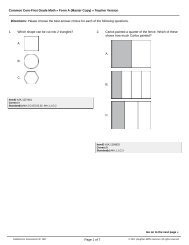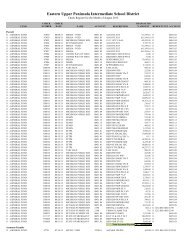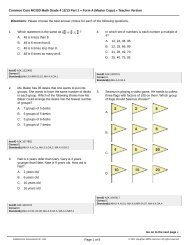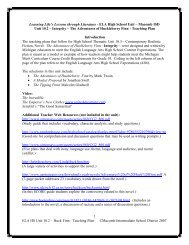Teaching Algebra with Manipulatives
Teaching Algebra with Manipulatives
Teaching Algebra with Manipulatives
You also want an ePaper? Increase the reach of your titles
YUMPU automatically turns print PDFs into web optimized ePapers that Google loves.
Chapter 9 <strong>Teaching</strong> Notes and Overview<br />
• Demonstration 1 involves factoring the<br />
perfect square trinomial x 2 2x 1. <strong>Algebra</strong><br />
tiles are used to model the factoring.<br />
• Demonstration 2 deals <strong>with</strong> factoring the<br />
perfect square trinomial x 2 4x 4. <strong>Algebra</strong><br />
tiles are used to model the factoring.<br />
• The Extension focuses on analyzing the<br />
information gained from the demonstrations.<br />
Answers<br />
Answers appear on pages 168–169.<br />
Mini-Project<br />
Multiplying Trinomial Squares<br />
(p. 170 of this booklet)<br />
Use With Lesson 9-6.<br />
Objective Model and factor perfect square<br />
trinomials using algebra tiles.<br />
Materials<br />
algebra tiles*<br />
* available in Overhead Manipulative Resources<br />
Have students work in small groups to draw the<br />
rectangular regions that model each trinomial.<br />
<strong>Algebra</strong> tiles may be used for this activity. You<br />
may want to check the models made by each<br />
group. Discuss the answers when the groups<br />
are ready. Allow time to exchange and share<br />
ideas on Exercises 9 through 12. Have students<br />
show their model for Exercise 12.<br />
Answers<br />
1. They are the same. 2. (x 2) by (x 2)<br />
3. (x 3) 2 4. (2x 1) 2<br />
5. (x 3)(x 1) 6. (x 1) 2<br />
7. (x 4) 2 8. (3x 1)(x 1)<br />
9. x 2 6x 9, 4x 2 4x 1, x 2 2x 1,<br />
x 2 8x 16<br />
10. perfect square trinomial<br />
11. The first and third terms are squares and<br />
the middle term is twice the product of the<br />
square roots of the first and third terms.<br />
12. (x 2)(x 2)<br />
<strong>Algebra</strong> Activity<br />
Factoring Trinomial Squares<br />
(pp. 171–172 of this booklet)<br />
Use With Lesson 9-6.<br />
Objective Model and factor trinomial squares<br />
using algebra tiles.<br />
Materials<br />
product mat* algebra tiles*<br />
classroom set of <strong>Algebra</strong> Activity worksheets<br />
transparency master of <strong>Algebra</strong> Activity<br />
* available in Overhead Manipulative Resources<br />
Cut the transparency on the dashed line. Then<br />
cut the squares and rectangles apart.<br />
Display the transparency and identify the<br />
representation of each shape. <strong>Algebra</strong> tiles may<br />
also be used. Arrange the model of x 2 2x 1<br />
to form a square.<br />
Ask students to state the length of each side.<br />
Ask what the relationship is between the length<br />
of the sides and the factors of x 2 2x 1.<br />
Display x 2 4x 4 on the transparency and<br />
arrange the models to form a square. Have students<br />
use algebra tiles at their seats if they wish.<br />
Students may cut their own models or use<br />
algebra tiles to complete the worksheet.<br />
Answers<br />
1. They are the same. 2. (x 2) by (x 2)<br />
3. (x 3) 2 4. (2x 1) 2<br />
5. (x 1)(x 3) 6. (x 1) 2<br />
7. 2(x 2) 2 8. (x 4) 2<br />
9. (3x 1) 2 10. (3x 1)(x 1)<br />
11. (x 2)(x 2) 12. 1, 3, 4, 6, 7, 8, 9<br />
13. a perfect square trinomial<br />
14. The first term is a perfect square, last term<br />
is a perfect square, and the middle term<br />
must be twice the product of the square<br />
roots of the first and last terms.<br />
15. Write two factors that are the sum or<br />
difference of the square root of the first and<br />
last terms (and the same sign as the<br />
middle term).<br />
<strong>Algebra</strong> 1—Chapter 9<br />
© Glencoe/McGraw-Hill 155 <strong>Teaching</strong> <strong>Algebra</strong> <strong>with</strong> <strong>Manipulatives</strong>







